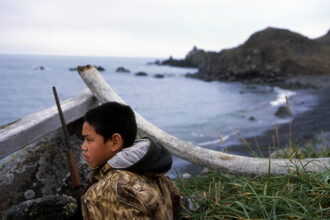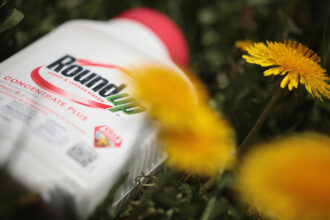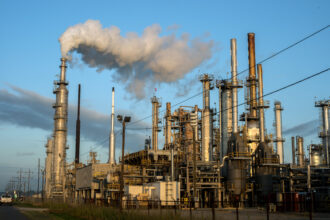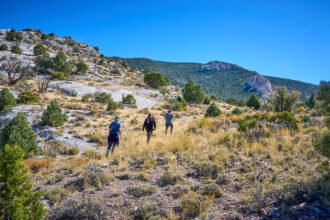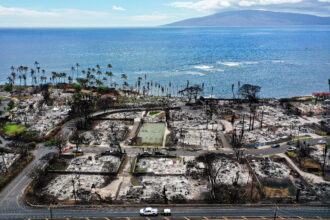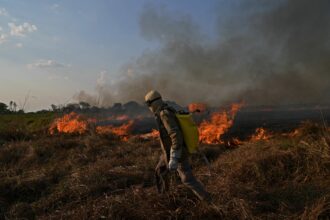Young children go to schools within just 200 feet of farms where pesticides are likely to be sprayed, a new analysis of farms across the country has found. Although most states have laws restricting how and when pesticides can be applied near schools, pesticide companies and their allies in Congress are trying to preempt such laws, the report warned.
Farmers apply about a billion pounds of pesticides every year in the United States, including a dozen particularly dangerous compounds banned in the European Union. Growers may be applying any number of toxic pesticides within just 200 feet—about the length of an ice hockey rink—of more than 4,000 elementary schools, researchers with the nonprofit Environmental Working Group reported in the new analysis released Thursday.
The analysis shows why it’s so important to protect state and local laws that are designed to protect kids from pesticides, said Scott Faber, head of government affairs for the Environmental Working Group, at a press briefing.
“Thousands and thousands of schools are located near farms where pesticides may be sprayed,” Faber said. “To protect our kids when they’re at school, many states, cities and counties have adopted legal standards to restrict pesticide spraying near schools.”
Yet some members of Congress are trying to block or preempt those state and local laws, Faber said. “They’re putting the profits of pesticide companies like Bayer’s Monsanto and pesticide applicators ahead of the risks posed to our kids.”
Bayer and Monsanto, which was acquired by Bayer in 2018, spent more than $1.5 million on campaign donations in the last five years, according to data from Open Secrets, which tracks money in politics.
It’s well known that pesticides can drift from the fields where they’re applied and travel several miles on a breeze.
Even low doses of pesticides can harm children, particularly during critical windows of neurodevelopment. Children exposed to pesticides in the womb later face a greater risk of childhood cancer and are more likely to score lower on IQ tests, show abnormal reflexes and have attention problems with and without hyperactivity, among other problems.
Roughly 2 million children at the schools flagged in the report could be exposed to harmful pesticides, based on data from the National Center for Education Statistics.
Communities of color and low-income communities face the highest risk from exposure to pesticides in both rural and urban settings, a study published last year in BMC Public Health found. In California, which leads the nation in pesticide use, Latino children were twice as likely to go to schools next to fields with the highest pesticide use, a 2014 study found.
Beyond the halls of Congress, this is not a partisan issue, said Sen. Cory Booker (D-N.J.) at the briefing. “It’s an issue based on science and fact,” he said. “Parents, school districts, local leaders clearly have shown they do not want their kids exposed to these toxic chemicals.”
More than 30 states have passed restrictions on pesticide use near schools. Some, like California, prohibit application of the chemicals within about 1,300 feet of schools and limit the times they can be used. Even “red states” like Kentucky and Texas have passed laws to protect school kids from harmful pesticides, such as limiting what can be sprayed and notifying parents, Faber said.
“But despite all of that,” Booker said, “stunningly to me, and frankly, it makes me angry, some members of Congress are now proposing to preempt all of these laws, stripping states and localities from being able to do what’s necessary to protect their children.”
Booker pointed to efforts to add language to the 2023 Farm Bill, an omnibus bill passed every five years, that would undo health-protective state and local laws. And several bills in the House and Senate would specifically prohibit pesticide protections by preventing states from requiring warning labels and forcing federal regulators to rely on outdated science.
Booker first introduced legislation to ban dangerous pesticides from agriculture in 2021 and reintroduced the bill again this year. The bill would ban pesticides proven to harm the safety of people and the environment, including paraquat, which damages the heart, kidneys and brain, and neonicotinoids, which harm pollinators and are suspected of driving declines of bees that support the nation’s food system.
Keep Environmental Journalism Alive
ICN provides award-winning climate coverage free of charge and advertising. We rely on donations from readers like you to keep going.
Donate NowPesticides are applied within 200 feet of more than 320 elementary schools in California, according to the new report. The report did not identify which pesticides are being used. But the most recent state data show that paraquat was among California’s top 100 pesticides in 2021, when growers sprayed more than 420,000 pounds of the dangerous chemical.
“We know that pesticides such as glyphosate and paraquat have known health harms, this is not speculation,” said Booker, noting that children, whose bodies are still developing, are most at risk.
The agrochemical giant Bayer paid more than $60 billion for Monsanto and its best-selling glyphosate weed killer. Bayer has settled more than 100,000 lawsuits worth billions of dollars from people claiming the companies failed to disclose the weed killer’s cancer risks. Research published earlier this year found evidence that children exposed to the chemical can develop diabetes and cardiovascular disease.
Two glyphosate formulations ranked number six and seven in California’s list of the top 100 pesticides used in the state, with more than 10 million pounds of the weed killer applied in 2021.
Most of the active ingredients in conventional pesticides that kill insects and weeds are synthesized from hydrocarbons in petroleum. A recent study of 24 pesticides published in the journal Toxics found that petroleum residues magnify the toxicity of the compound to 1,000 times that of the active ingredient, which regulators test to determine health and environmental safety.
Phasing out fossil fuels will not just benefit the climate, health experts say, it will also protect public health and the environment.
Whatever your political philosophy, Booker said, protecting vulnerable children shouldn’t be controversial. He’s trying to sound the alarm to stop big pesticide companies and their lobbyists from undermining local public health measures.
“I will be one of these people taking every measure possible not to let this preemption happen,” said Booker.







